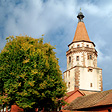ST MARTIN’S ABBEY BASILICA WEINGARTEN
Germany’s Largest Baroque Church and the Blood Relic
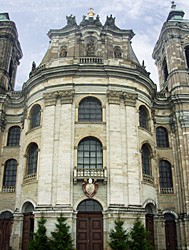 The Weingarten Abbey and the St. Martin's Basilica stand out on the road through the Swabian hills between Friedrichshafen and Ulm just outside of Ravensburg, surrounded by the town of Weingarten. It is the largest Baroque design church in Germany and the second largest church in country after the Cathedral of Cologne. It is sometimes called the "Swabian St. Peter's", designed to be one-half the size of the Vatican’s St. Peter's Basilica in Rome. The present church was built between 1715 and 1724 in the Italian-German Baroque style from architectural plans by Franz Beer.
The Weingarten Abbey and the St. Martin's Basilica stand out on the road through the Swabian hills between Friedrichshafen and Ulm just outside of Ravensburg, surrounded by the town of Weingarten. It is the largest Baroque design church in Germany and the second largest church in country after the Cathedral of Cologne. It is sometimes called the "Swabian St. Peter's", designed to be one-half the size of the Vatican’s St. Peter's Basilica in Rome. The present church was built between 1715 and 1724 in the Italian-German Baroque style from architectural plans by Franz Beer.
A main feature inside the church is the impressive Baroque Gabler Organ built by Joseph Gaber sometime between 1735 and 1750, with its more than 6,000 pipes. A wing of the surrounding abbey accommodates the still active monastery of St Martin’s. Other parts of the former abbey house the Education University of Weingarten and the Academy of the Diocese of Rottenburg-Stuttgart.
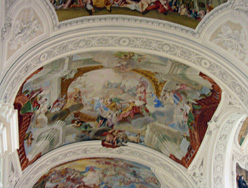 Welf I, Duke of Bavaria, whose seat was Ravensburg, founded the first Benedictine monastery on the Martinsberg mountain overlooking the village of Altdorf in 1056, when he came into possession of a relic of Jesus’ crucifixion, the relic of the Precious Blood. He named the abbey Weingarten, German for vineyard, for the wine making activity of its monks, and the nearby village took the name of the monastery to become the present town of Weingarten in 1865. In 1126, Henry IX, Duke of Bavaria, after his abdication, died a year after settling at the monastery and was buried in the church. In 1274, designated as a “Reichsabtei”, only answering to the emperor, the monastery acquired territory stretching from the Allgau to the Lake Constance, making it one of the richest monasteries in southern Germany. Aside from their occupation with grapes the monks spent much of their time illustrating medieval manuscripts.
Welf I, Duke of Bavaria, whose seat was Ravensburg, founded the first Benedictine monastery on the Martinsberg mountain overlooking the village of Altdorf in 1056, when he came into possession of a relic of Jesus’ crucifixion, the relic of the Precious Blood. He named the abbey Weingarten, German for vineyard, for the wine making activity of its monks, and the nearby village took the name of the monastery to become the present town of Weingarten in 1865. In 1126, Henry IX, Duke of Bavaria, after his abdication, died a year after settling at the monastery and was buried in the church. In 1274, designated as a “Reichsabtei”, only answering to the emperor, the monastery acquired territory stretching from the Allgau to the Lake Constance, making it one of the richest monasteries in southern Germany. Aside from their occupation with grapes the monks spent much of their time illustrating medieval manuscripts.
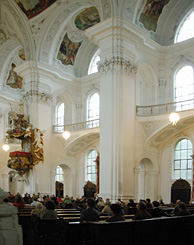 The old Romanesque abbey church was demolished and replaced by the present Baroque ediface beginning in 1715, built on a scale commensurate with the wealth of the monastery, designated as a “basilica minor” in 1956. The north wing which would have made an ideal square would have blocked the imperial road, today St. Longinus Strass, part of the Upper Swabian Baroque Route (Oberschwäbische Barockstrasse), with construction of the north wing stopped in 1728, and the southern wing extended instead.
The old Romanesque abbey church was demolished and replaced by the present Baroque ediface beginning in 1715, built on a scale commensurate with the wealth of the monastery, designated as a “basilica minor” in 1956. The north wing which would have made an ideal square would have blocked the imperial road, today St. Longinus Strass, part of the Upper Swabian Baroque Route (Oberschwäbische Barockstrasse), with construction of the north wing stopped in 1728, and the southern wing extended instead.
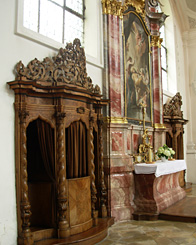 The monastery has had a checkered history in modern times. The abbey was dissolved in 1806 with the end of Austrian control and the land became part of the Kingdom of Wurttemburg. A monastery was re-established in 1922 by some Benedictines from Birmingham England. They were forced out during the National Socialist era, but came back after the war. There were only 4 monks left by 2009 and the abbey was vacated in 2010. Since 2015, some of the residential rooms have been offered for the settlement of refugees. The remaining monks oversee the reliquary and the “Blood Ride” procession.
The monastery has had a checkered history in modern times. The abbey was dissolved in 1806 with the end of Austrian control and the land became part of the Kingdom of Wurttemburg. A monastery was re-established in 1922 by some Benedictines from Birmingham England. They were forced out during the National Socialist era, but came back after the war. There were only 4 monks left by 2009 and the abbey was vacated in 2010. Since 2015, some of the residential rooms have been offered for the settlement of refugees. The remaining monks oversee the reliquary and the “Blood Ride” procession.
The Blood Relic
The most famous treasure of Weingarten is its relic of the Sacred Blood. The legend is that Longinus, the soldier who pierced Jesus's side with a lance (see Vienna Treasure Chamber), collected some of the blood and preserved it in a lead-lined box, which he buried in Mantua. The box was miraculously discovered in 804 and proclaimed a true relic by Pope Leo III, but then buried again in the face of pending invasions. It was found again in 1048 and exalted by Pope Leo IX. The relic was then divided into three parts, one of which went to Rome, another was given to the Holy Roman Emperor Henry III, and the third remained at Mantua. Henry III bequeathed his share of the relic to Baldwin V, Count of Flanders, who then gave it to his daughter, Juditha. When Juditha married Welf I, the Duke of Bavaria, the relic found its home at Weingarten. A solemn presentation took place in 1090, on the Friday following the feast of the Ascension, and it was declared that a celebration would be held yearly on the same day, which came to be known as “Blood Friday” (Blutfreitag), when the relic would be carried in a solemn procession.
The demonstration was prohibited in 1812, but has continued since 1849, known as Blood Ride (Blutritt). The relic is carried by a rider, “der heilige Blutritter”, followed other horses and thousands of celebrants on foot. The original reliquary of gold set with jewels was confiscated during the suppression of the monastery and replaced with a gilded copper replication. © Bargain Travel EuropeBest
vacation deals compare prices in Bavaria
at TripAdvisor
These articles are copyrighted and the sole property of Bargain Travel Europe and WLPV, LLC. and may not be copied or reprinted without permission.
See Also:
ST ANNE'S CHURCH - LUTHERSTIEG - AUGSBURG

